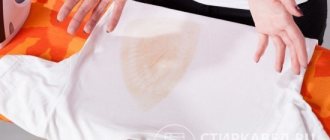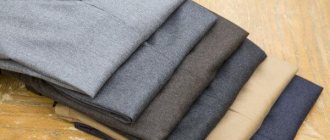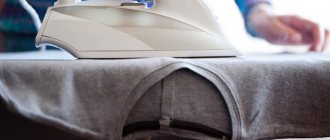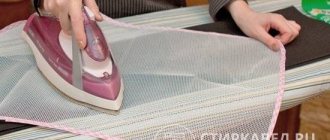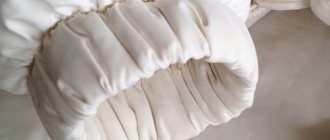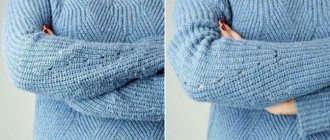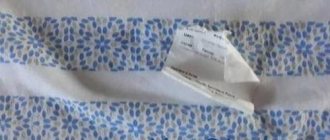Every lover of business style clothing sooner or later faces the fact that his suit begins to shine. Unwanted marks appear that spoil the appearance of the product. This happens more often with pants than with a jacket or skirt. And visually, the once beloved trousers look pretty worn.
The main reason for the appearance of a shiny shine on clothes is improper ironing of the product. If you do not follow the rules, the same lasses may appear on jackets and skirts as on trousers. You can remove shine from your iron by spending some time and effort, but it is much easier to prevent its appearance.
Reasons for the appearance of shine on clothes
A shiny sheen appears on areas of clothing that are subject to intense friction when worn. The fabric can rub against other matter and come into contact with the skin, as a result of which the sebum leaves shiny marks over time.
The most problematic areas:
- collar;
- buttock area and crotch seam;
- knee area;
- pockets;
- sleeve cuffs.
Shiny areas are formed both during wear and when mistakes are made while ironing the item. Fortunately, all this can be eliminated and give clothes a fresh look. Nobody wants to look sloppy!
Soap
You can get rid of shiny marks using soap. To do this, the gauze through which the item will be ironed must be moistened in a soap solution. After ironing, the item should be rinsed in clean water until the soap is completely washed away.
You can apply the soap solution with a spray bottle, especially since this solution can then be used for cleaning.
How to iron clothes correctly so that there is no shine left?
To remove shine from trousers and any clothing, it is important to learn how to iron it correctly. It’s not for nothing that manufacturers sew in tags with care and washing instructions. But many people ignore them, hence the result.
How to iron clothes, how to remove shine and prevent shine:
- A good iron is the key to quality ironing. Monitor the cleanliness of the sole and the quality of the water poured into the compartment. To avoid scale remaining, promptly clean the iron container from dirt and use only purified or distilled water;
- Correctly set temperature conditions and the steam function will get rid of the unpleasant shine on clothes. Cotton and thick denim can withstand maximum conditions, synthetics love delicate ironing;
- natural fabrics and wool that require careful care are ironed through gauze or a flat iron;
- suit trousers and dark fabrics prone to gloss are ironed on the reverse side.
Advice. If you have a steamer in your home, it is better to use it to treat clothes that are prone to shine from the iron.
Wool fabric
A product such as onions can be found in any home. It can be used not only for preparing various dishes, but also to remove lasa from pants or dress. They act like this:
- Peel the onion and cut it.
- Rub one of the halves onto the stain. Continue the procedure until it becomes lighter.
- All that remains is to wash the item by hand or in the washing machine with plenty of fabric softener. This way you can neutralize the unpleasant smell of onions.
How to remove shine from iron?
If trouble does happen, and after ironing the clothes become shiny at the seams, pockets, or collar, then you don’t always need to send the item to the wash again. Some products allow you to get rid of shine in a targeted manner and return things to a neat appearance.
Table vinegar
There are two ways to use vinegar to remove unwanted shine and shiny areas of clothing:
- Soak the fabric in a weak solution of vinegar or 9% table vinegar. Sprinkle salt on top of the shiny, vinegar-treated area and wait until it absorbs moisture. Shake off the residue, dry (you can steam it through cheesecloth with an iron);
- Soaking in a weak vinegar solution. Pour warm water into a container and add a couple of tablespoons of vinegar until the water becomes just barely acidic. Soak the entire item for a couple of hours, then wash it by hand or in a washing machine.
Important. Vinegar leaves unsightly stains on dark things, but it works great on white things.
Ammonia
Ammonia is used as a stain remover; in particular, it helps remove shine from iron and shiny marks on light-colored clothes and wool products.
A weak aqueous solution is prepared (about 10 ml of alcohol per glass of warm water), a teaspoon of table salt is added, and mixed. You should wet the problem area and iron it through gauze or a flat iron until the shine disappears.
Laundry soap
The soap solution is applied with a sponge or brush to the contaminated surface; you can rub it lightly. Residues of soap are removed with a wet, clean sponge from the edges to the center to avoid soap stains. Clothes can be dried naturally or ironed through gauze until dry.
Boric acid
Boric acid is used as a stain remover and a savior of clothes from unsightly stains after ironing, similar to acetic acid.
It is enough to dissolve boric liquid in warm water at the rate of 1 tablespoon per liter of water, place the item there and leave to soak. Standard rinsing and drying procedures follow.
Onion
Let's talk about somewhat unusual methods for removing iron shine from clothes. For example, onion gruel, as it turns out, can solve this problem, and quite effectively.
The principle of use may differ: you either grate the onion on a fine grater until it becomes a paste and apply it to a shiny area, or you make a fresh cut of the vegetable and thoroughly grate the desired area. The point is to ensure that the onion juice is properly absorbed into the fibers. To be more effective, the mass is left on the fabric for a while, then removed, and the item is rinsed and dried.
Advice. After such a procedure, a specific onion smell may emanate from the fabric. You can get rid of it by adding conditioner when rinsing or thoroughly steaming your clothes after washing.
Potato
This root vegetable, beloved by many, will help remove shine from the iron on dark trousers and other clothes.
How to remove shine using potatoes:
- Cut a clean potato in half to extract the juice;
- treat the greasy area with a fresh cut;
- leave until dry.
Advice. Remember that potatoes contain a lot of starch, and traces of it may remain after the fabric dries. We go through the fibers with a clean soft brush and remove unwanted plaque.
Wool fabric
Natural fibers require delicate handling, and this also applies to removing shiny iron marks. If wool items are ironed incorrectly, it is very easy to leave them.
There are several ways to remove shine from wool clothes:
- use of ammonia diluted with water spotwise;
- the bulb is also good at removing shine from fur;
- use damp gauze or a thin towel. Try ironing the area thoroughly using steam from the iron. This will cause the villi to rise and the gloss will disappear.
Silk fabric
soda ash on hand We invite you to get acquainted with this method in more detail:
- You must first prepare a special mixture. Mix lye powder with water until a thick paste forms.
- Apply the resulting mixture to the shiny stain and wait until it hardens on the surface of the fabric.
- Next, rinse the item in warm water.
- During the next ironing procedure, choose a gentle mode to prevent repeated damage to the fabric.
Tip: There is another way to deal with stains on silk products. It is enough to mix water and peroxide in a 1:1 ratio. You must first treat the stain with this product, and then dry it in any available way.
How to remove shine from socks?
Shiny areas are of a completely different nature, appearing not when ironing technology is violated, but when the item is worn for a long time. Parts of clothing that are most exposed to friction and contact with the skin, without timely care and long-term use, lose their appearance, become greasy and have an unattractive shine. And this problem can be solved with improvised means right at home.
Steaming
As in the case of iron marks, you can remove the shine from wear from trousers by steaming without ironing with a burst of steam or a steamer. Contamination lags behind the fibers and is easily removed. This method is especially relevant for clothes that cannot be washed, for example, jackets with natural filling, down jackets, suits and trousers.
Advice. If washing is possible, then it is better to wash the product. It's more reliable. Next, we simply do not use standard ironing, but put the item in order using steam treatment. The gloss will disappear.
Paper
It will be good if the paper absorbs well. A paper napkin or towel or baking paper will do.
Important. Other types of paper will solve the problem partially, or even add hassle. For example, it is undesirable to use printed materials because of the ink and photo printing on them, and thick printer and writing paper does not cope well with the task.
What do we have to do:
- attach paper to the required area, after first spreading the item evenly on the ironing board;
- run the iron over it and press it well. The paper should absorb greasy marks from clothing;
- repeat the manipulations until the shine disappears completely.
Tea
It is believed that strong tea leaves can also remove shine from trousers and other clothes.
Important. The method is applicable to dark fabrics due to the coloring properties of the tea. Otherwise, you will have to wash out the resulting tea stain.
Your actions:
- Brew the tea so that it becomes a strong brew, cool to room temperature;
- dip a cotton pad or a piece of clean cotton rag into the tea leaves, let it soak, and squeeze it out well;
- we treat shiny areas;
- iron the item through a thin fabric or iron until dry.
Refined gasoline
Often the fuel is used to combat stubborn stains on trousers and other clothing. It can also be applied to our situation by treating the problem area with a dampened cloth. After the final stage: a solution of ammonia (1 part alcohol and 5 parts water) is applied to the treated area with a sponge, then we leave the clothes to dry. If necessary, follow up with regular washing.
Soda
Truly an amazing and multifunctional substance! Soda will help even if you need to remove shine from trousers and other clothes, regardless of the nature of the origin of the marks.
- Soda is diluted with water to a thick porridge.
- The gruel is distributed over shiny areas until dry.
- Remains of the substance are brushed off with a soft brush.
Advice. Use baking soda carefully on natural, delicate fabrics! It is better to check the action from the inside out or in an inconspicuous place.
Pumice
One of the radical ways to combat shine on trousers and jackets. Good for things made of thick denim or rough fabric. Principle: mechanically “ruffle” the fibers, thereby eliminating their shine. This will not save you from pollution, it will only disguise them. But if you need to act quickly, but don’t have time to do laundry, this method can work.
It is enough to walk with fine-grained pumice over greasy areas. Proceed carefully - too much effort can leave holes and scuffs, and they are much more difficult to fix.
Cleaning a leather and faux leather jacket
Very quickly, jackets made of leatherette and genuine leather begin to shine on the collar and sleeves.
To remove unsightly shine, you can use some available tools that are most often found in every home. For example, if you dilute ammonia 1:4 with plain water, you will get an excellent cleansing solution for the skin. You just need to moisten a cotton pad and wipe the greasy areas on the product with it. When the cotton wool becomes dirty, it needs to be replaced with clean one.
Greasy stains from natural leather can be removed with a crumb of white bread. Simply rub the problem areas with bread until the dirt comes off.
Oily shine can be removed from natural light suede using fresh skim milk. To do this, you need to dissolve 1 tsp in 200 ml of warm milk. baking soda and add 5 drops of hydrogen peroxide. Use a prepared solution to wipe the problem areas with a piece of cotton wool. Remains of the product are removed with a clean and damp cloth.
If natural suede or nubuck has become shiny, you can remove unsightly marks by steaming. The item is simply held over the spout of a boiling kettle for several minutes or treated with a steamer. When the skin is steamed, remove the layer of dirt with a brush. Do not press the brush on wet suede, as this may damage it.
Leatherette can be easily cleaned with ethyl alcohol. You just need to moisten a cotton pad with alcohol and treat the problem areas with it. After this, the skin is wiped with a piece of lemon, the juice is washed off, and then rubbed with glycerin. First, you should conduct a small test to check the reaction of the leatherette to ethyl alcohol.
White artificial leather is cleaned with milk in the same way as natural leather. Milk also effectively removes stains that often remain after removing stains.
Another way to remove shiny areas on leatherette is to wipe them with baking soda. To do this, apply a little baking soda to a damp sponge and use it to treat the surface of the jacket.
Useful tips
Finally, some useful tips:
- do not neglect the ironing rules; often problems can be prevented at this stage. Iron mainly from the wrong side, and it is better to iron “capricious” fabric with damp gauze or interlayer fabric;
- Monitor the condition of the iron. A dirty soleplate or scale deposits in the appliance can complicate routine household processes;
- Treat complex fabrics with a steamer or steam blow from an iron;
- It is better to dry pants vertically on a special hanger. Often there is a shine left on the trouser fabric from clothespins or drying rope;
- Do not allow your outerwear to become heavily soiled. Light shine can be removed at home, but extensive stains are best removed by dry cleaning;
- Before processing, check the reaction of the fabric to aggressive agents on the wrong side or a special piece of cloth (manufacturers often attach them specifically for these purposes along with tags and spare accessories).
Properly preparing a down jacket for washing
If, as a result of the inspection, stubborn stains are found, which are most often found on the collar and sleeves, then you should not hesitate, but it is recommended to use the advice of experienced housewives, because the tricks adopted will help get rid of stains.
Before you begin the procedure, you must carefully study the information on the labels, which indicate washing methods and approved detergents. Based on the information provided by the manufacturer, the owner of a down jacket must clearly understand:
- washing temperature;
- Is it possible to dry clean a down product?
- Is washing in an automatic machine acceptable?
- What methods of drying and ironing are provided?
Folk remedies
If it is not possible to use aggressive chemicals for washing, then you can try using folk recipes. Sometimes improvised means are much more effective than expensive powders and gels.
A great way to wash shiny places on things is ammonia, tested by many housewives. Ammonia can be used to clean not only bolognese fabric, but also natural suede.
Dissolve 50 ml of the drug in 200 ml of warm water and use a sponge to treat the stained areas of the product. After this, all you have to do is rinse the jacket in cool water and dry it - all the shine will disappear.
Potatoes are an unusual way to quickly remove shine, but they are very effective. It is enough to rub the shiny parts with a cut of a raw potato, and then wash the item, and all the dirt will disappear.
Salt and alcohol are suitable for cleaning all types of fabric. First, the shiny areas are wiped with a cotton swab soaked generously in medical alcohol, and then a thick layer of salt is poured onto the still wet mark. After a couple of minutes, you need to brush the clothes.
Our grandmothers used glycerin in everyday life to remove stains from things. A cotton swab should be soaked in liquid glycerin, which is sold in pharmacies, and applied to all affected areas on the product. After 15 minutes, the item must be washed with soap or powder, or put in the washing machine.
Folk remedies
If it is not possible to use aggressive chemicals for washing, then you can try using folk recipes. Sometimes improvised means are much more effective than expensive powders and gels.
A great way to wash shiny places on things is ammonia, tested by many housewives. Ammonia can be used to clean not only bolognese fabric, but also natural suede.
Dissolve 50 ml of the drug in 200 ml of warm water and use a sponge to treat the stained areas of the product. After this, all you have to do is rinse the jacket in cool water and dry it - all the shine will disappear.
Potatoes are an unusual way to quickly remove shine, but they are very effective. It is enough to rub the shiny parts with a cut of a raw potato, and then wash the item, and all the dirt will disappear.
Salt and alcohol are suitable for cleaning all types of fabric. First, the shiny areas are wiped with a cotton swab soaked generously in medical alcohol, and then a thick layer of salt is poured onto the still wet mark. After a couple of minutes, you need to brush the clothes.
Our grandmothers used glycerin in everyday life to remove stains from things. A cotton swab should be soaked in liquid glycerin, which is sold in pharmacies, and applied to all affected areas on the product. After 15 minutes, the item must be washed with soap or powder, or put in the washing machine.
Black tea
It is quite possible that while thinking about the question you will just have tea. There is a reason to put the cup aside and start restoring the attractive appearance of your clothes. Make an infusion of strong tea, wet a piece of cloth with it and wipe the shiny areas on your trousers. Then dry them and iron them through gauze.
In the most extreme cases, you can try to remove the gloss by gently rubbing the affected areas with pumice. But it makes sense to resort to this method only when other methods have proven ineffective.
Steaming - cleaning shiny areas on your knees
If your trousers are shiny at the knees, you can use steaming. This method will only be effective if the item is not very worn.
The cleaning procedure is as follows:
- The trousers are washed in the usual way.
- When wet, the product is suspended over a bathtub filled with hot water.
- After a couple of times, the slightly shiny areas are brushed.
- After this, the item is dried and ironed in compliance with all the rules.
Features of such pollution
The reasons why the collar is shiny may be the following:
- Sweat got on the fabric.
- Grease stains.
- Presence of dirt.
- The fabric was subjected to friction.
- Some other reasons.
It is important to note that regular washing will not solve the problem of a greasy jacket or collar.
For complete cleaning, special methods must be used. In order for cleaning to be effective, you need to perform the following steps:
- First you need to understand exactly what fabric needs to be cleaned. To do this, you need to carefully examine the labels on the jacket or collar. When working with different types of materials, the cleaning procedure may vary.
- It is necessary to understand the nature of the existing contaminants. These could be, for example, stains from cosmetics, grease or sweat.
- Before cleaning the stain, you need to wipe the greasy area in order to partially remove the dirt. It is convenient to use a damp cloth for this.
To remove stains on a jacket or collar, you can use household chemicals or home treatment methods.
If there are any shortcomings...
At home, it will not be easy for novice housewives to iron out perfect arrows. Some common errors are easy to fix:
- to remove false arrows, gauze is moistened in a solution of 2 tablespoons of 9% table vinegar and 1 liter of water and steamed from the inside out;
- the use of fabric overlays will eliminate unnecessary gloss;
- a spray bottle also combats this problem. Sometimes it can be eliminated only by washing with the addition of laundry soap;
- To keep the material ironed during transportation, fold it with a small roller.
Some features and tricks...
- Pre-treatment of trouser legs requires slightly pulling the trousers on an ironing board or placing a pad under problem areas;
- Rotate the product around its axis, turning it over to the other edge;
- Do not press the steamer too hard, but only lightly, as seams are imprinted and the structure of light fabrics is deformed in direct contact with the heating device;
- For some dense fabrics, use the steam function, which is possible even without ironing;
- Try not to wet synthetics so as not to leave streaks on it. Use wet wipes to eliminate the formation of creases or bruises;
- Periodically let the material cool so that excess moisture evaporates;
- As additional fasteners, secure the top and bottom of the trouser legs with paper clips;
- If you wipe the underside in the area of future folds with soap slightly moistened with water, a brilliant result is guaranteed;
- Simply iron undried pants or spray them with a spray bottle, place them in a bag for 10–20 minutes and get started;
- Mark a straight line with the teeth of an ordinary comb, which you first wet;
- If you spray the inside with a mixture of vinegar + water at the rate of 1 tablespoon per 1 liter and add a little starch, this will strengthen the bends.
RESULT
Everyone knows the popular wisdom: “You meet people by their clothes...”. In order not to spoil your karma and make a good impression, put your clothes in order.
If you don’t know how to iron trousers with creases, then we will tell you. Don’t wonder anymore: how to do it faster and better?
And some details and nuances will guarantee the effect of long-lasting and symmetrical curves. I wish you success!
